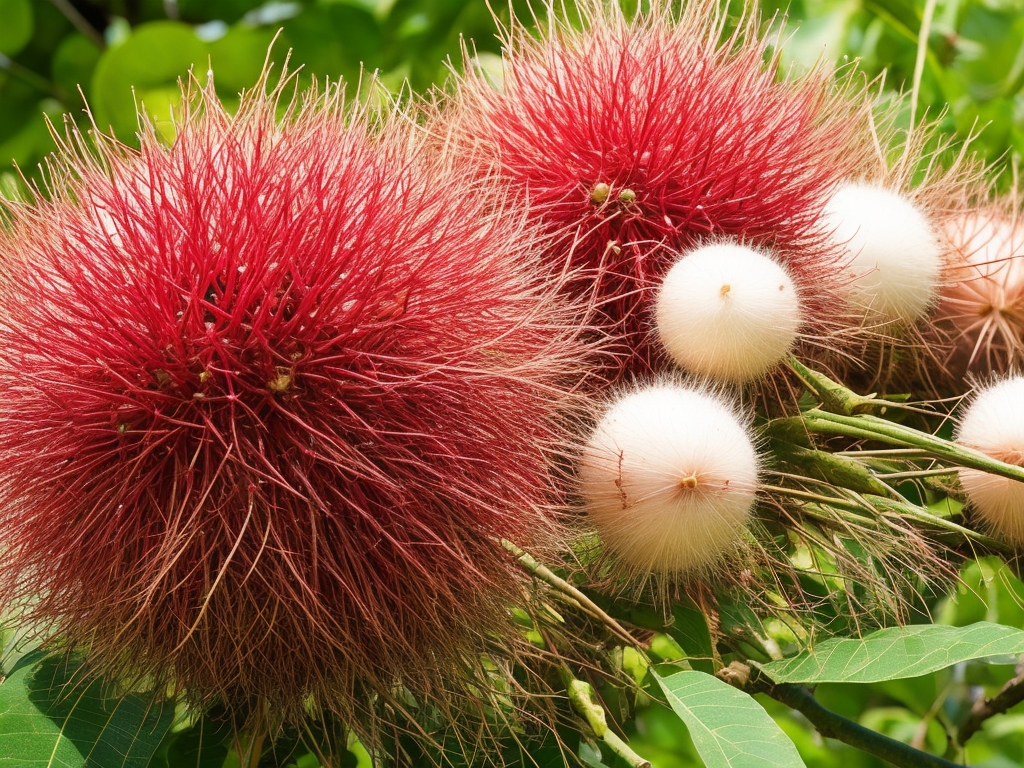Welcome to the fascinating world of rambutan in english! In this guide, you will learn all about this exotic fruit and its interesting characteristics. From its spiky exterior to its juicy and sweet flesh, you will discover everything you need to know about rambutan.
Firstly, let’s start with the basics. Rambutan in english, also known as “hairy lychee,” is a tropical fruit that is native to Southeast Asia. It gets its name from the Malay word “rambut,” which means hair, due to its hairy and spiky appearance. The fruit is about the size of a golf ball and has a red or yellowish skin. Once you peel back the skin, you will find a translucent, juicy flesh that is similar to a lychee in taste and texture. In this guide, we will delve into the origins, nutritional benefits, and how to enjoy this exotic fruit. So get ready to embark on a delicious adventure with rambutan!

All About Rambutan: A Guide to this Exotic Fruit
Welcome to the world of rambutan in english, a unique and delicious fruit that is native to Southeast Asia. This friendly guide will introduce you to everything you need to know about rambutan, from its origin and nutritional value to its culinary uses and cultural significance. So, let’s dive in and explore the exciting world of rambutan!
What is Rambutan?
Definition of Rambutan
Rambutan is a tropical fruit with a fascinating appearance and a sweet, juicy taste. The name “rambutan in english” is derived from the Malay word “rambut,” which means “hair,” referring to the hairy outer covering of the fruit. The scientific name for rambutan is Nephelium lappaceum, and it belongs to the Sapindaceae family. This fruit is often compared to lychee due to their similar taste and appearance.
Origin and Distribution
Rambutan has its origins in the Malay Archipelago and is believed to have been cultivated for centuries in this region. Today, it is widely grown in countries such as Thailand, Indonesia, Vietnam, and Malaysia. Due to its growing popularity, rambutan has also been introduced to other tropical regions around the world, including Central and South America, the Caribbean, and even parts of Africa.
Physical Characteristics
Rambutan may look intimidating at first glance, but once you peel away its hairy exterior, you’ll discover a tasty and refreshing treat. The fruit is small to medium-sized, roughly around 2 to 3 inches in length. It has a round shape, and its skin is covered in soft, hair-like spines that are typically green or red in color.
Once you remove the skin, you will find a translucent white or pale pink fruit with a sweet and slightly acidic taste. Nestled within the fruit’s flesh is a large seed, which is inedible and needs to be discarded.
Nutritional Value of Rambutan
Calories and Macronutrients
Rambutan is not only a delightful fruit to eat but also a nutritious addition to your diet. A 100-gram serving of rambutan provides approximately 68 calories. It is low in fat and cholesterol-free, making it a healthy choice for those watching their calorie intake.
Rambutan in english is also a good source of carbohydrates, mainly in the form of natural sugars such as fructose and glucose. These sugars provide a quick source of energy, making rambutan an excellent snack option.
Vitamins and Minerals
In addition to being a great source of energy, rambutan is packed with various vitamins and minerals. It is particularly rich in vitamin C, which plays a vital role in boosting the immune system and promoting healthy skin.
Rambutan in english also contains significant amounts of manganese, a mineral that helps support bone health and proper metabolism. Additionally, it provides small amounts of iron, calcium, and phosphorus, which are all essential for maintaining overall health.
Health Benefits
Apart from its delightful taste, rambutan offers several health benefits. Its high vitamin C content makes it an effective antioxidant, helping to combat the harmful effects of free radicals in the body.
Rambutan also contains dietary fibers, which aid in digestion and prevent constipation. Furthermore, the fruit contains natural compounds that possess antimicrobial properties, potentially protecting against certain bacterial infections.
How to Select and Store Rambutan
Choosing Ripe Rambutan
When selecting rambutan, it is important to choose ripe fruit to ensure you enjoy the best taste and texture. Look for rambutan that has vibrant and evenly colored skin. Avoid fruits with blemishes or bruises, as they may indicate poor quality or overripeness.
Proper Storage Techniques
To keep your rambutan fresh for longer, store them in a cool, dry place away from direct sunlight. You can store them at room temperature for a day or two, but if you want to extend their shelf life, refrigeration is recommended. Place the rambutan in a plastic bag or airtight container before storing them in the refrigerator.
Tips for Prolonging Freshness
To ensure maximum freshness, it is best to consume rambutan within a few days of purchase. If you have a large quantity, consider freezing them. Simply peel the fruit, remove the seed, and store the flesh in an airtight container in the freezer. Frozen rambutan can be used to make smoothies or added to desserts.
Different Ways to Enjoy Rambutan
Eating Fresh Rambutan
The simplest and most popular way to enjoy rambutan is to eat it fresh. After peeling away the hairy skin, you can simply pop the fruit into your mouth, savoring the juicy and sweet flesh. Be sure to spit out the large seed, as it is not edible.
Incorporating Rambutan in Recipes
Rambutan can be a versatile ingredient in various recipes, adding a unique flavor and texture to both sweet and savory dishes. You can dice the fruit and add it to fruit salads, desserts, or even use it as a topping for pancakes or waffles. It can also be used in savory dishes such as sauces or stir-fries, adding a touch of sweetness to balance the flavors.
Rambutan-based Drinks and Desserts
Rambutan can be transformed into refreshing beverages or delightful desserts. Try blending the peeled fruit with ice to make a delicious and flavorful rambutan smoothie. You can also use rambutan to create tropical popsicles or incorporate it into fruity gelatin or custard desserts for a delightful treat.
Culinary Uses of Rambutan
Traditional Dishes
In the regions where rambutan is native, it is often enjoyed in traditional dishes and desserts. For example, in Indonesia, rambutan is commonly used in a popular dessert called “es rambutan,” which consists of shaved ice topped with sweet syrup and rambutan fruit. In Thailand, rambutan is used in both sweet and savory dishes, adding a burst of flavor to curries, salads, and even seafood dishes.
Regional Variations
Different regions have their own unique ways of incorporating rambutan into their culinary traditions. In Malaysia, rambutan is sometimes used as a filling for traditional kuih, a type of sweet cake. In the Philippines, it is often candied or used as an ingredient in fruit preserves. Each culture adds a distinctive touch to their dishes, showcasing the versatility of this exotic fruit.
Rambutan in International Cuisine
With globalization, rambutan has made its way into international cuisine as well. Chefs around the world have started experimenting with this tropical fruit, incorporating it into innovative recipes. From rambutan-infused cocktails to rambutan garnishes on gourmet dishes, this fruit has become a popular choice among culinary enthusiasts.
Cultural Significance of Rambutan
Religious and Festive Uses
The regions where rambutan thrives hold great cultural significance for this fruit. In certain cultures, it plays a vital role in religious ceremonies, symbolizing fertility and abundance when offered to deities. Traditional decorations and offerings during festive occasions frequently incorporate rambutan as a key element.
Symbolism and Folklore
Rambutan has also found its place in folklore and symbolism. Certain communities link the consumption of rambutan with good luck and the potential to attract prosperity. According to ancient folklore, this captivating fruit holds mystical properties and frequently intertwines with magical creatures and mythical beings.
Rambutan in Art and Literature
The beauty and allure of rambutan have inspired artists and writers throughout history. Many paintings, poems, and songs have been dedicated to this remarkable fruit, celebrating its vibrant colors and tantalizing taste. Rambutan has become a muse for creativity and a symbol of natural beauty in various art forms.
Horticultural Aspects of Rambutan
Cultivation and Growth
Rambutan trees thrive in tropical climates and require well-drained soil and ample sunlight for optimal growth. They prefer temperatures between 68°F to 95°F and high humidity levels. Rambutan trees can grow up to 20 to 66 feet tall, and they start producing fruits within four to six years.
Propagation Techniques
Rambutan trees are primarily propagated through seeds or grafting. Seeds can be collected from ripe fruit and planted in well-prepared soil. Grafting, on the other hand, involves joining a branch or bud from a desired variety onto a seedling or rootstock. This technique ensures the cultivation of specific rambutan varieties.
Common Diseases and Pests
Like any other crop, rambutan trees are susceptible to certain diseases and pests. The most common diseases include fruit rot, fungal infections, and leaf diseases. Pests such as aphids, mites, and fruit flies can also cause damage to the trees and fruits. Proper care, regular monitoring, and the use of organic pest control methods can help manage these issues.

Commercial Importance of Rambutan
Economic Value and Market Demand
Rambutan holds significant economic value in the countries where it is commercially grown. It has become an important cash crop, providing income and livelihood opportunities for many farmers and communities. The increasing demand for exotic tropical fruits, including rambutan, has further boosted its commercial importance.
Export and Import Statistics
Rambutan is exported to various countries around the world, especially those with a demand for tropical fruits. The primary exporters include countries like Thailand, Indonesia, Malaysia, and Vietnam. On the other hand, countries like the United States, Canada, and European nations are major importers of rambutan.
Rambutan in the Global Trade
Rambutan has become an integral part of the global trade of exotic fruits. Its popularity continues to rise as more people discover its unique taste and health benefits. Rambutan is no longer confined to its region of origin but has become an exotic delicacy beloved by fruit enthusiasts worldwide.
Rambutan Varieties and Hybrids
Different Rambutan Varieties
Rambutan in english comes in various varieties, each with its own unique features. Among the most sought-after varieties are the “Rongrien,” beloved for its generous fruit size and delightful sweetness, and the “Maharlika,” renowned for its vibrant red skin and exceptional juiciness.
Hybridization and Its Effect
Hybridization has played a significant role in the development of new and improved rambutan varieties. By crossbreeding different rambutan species, researchers and horticulturists have been able to create hybrids that combine desirable traits from multiple varieties. These hybrids often exhibit enhanced flavor, increased disease resistance, and improved productivity.
Popular Hybrid Rambutan Cultivars
Some of the popular hybrid rambutan cultivars include “Rapoza,” “Raub,” and “Chooi Ang.” These hybrids have gained popularity due to their exceptional taste, appealing appearance, and ability to adapt to different growing conditions. They have become sought-after varieties in both local and international markets.

Conclusion
Rambutan in english is a remarkable fruit that captivates both the palate and the imagination. Its unique appearance and delicious taste make it a favorite among fruit lovers worldwide. Whether enjoyed fresh, incorporated into recipes, or celebrated in cultural traditions, rambutan offers a delectable and enticing experience.
With its outstanding nutritional profile and numerous health benefits, rambutan is truly a fruit worth exploring. So the next time you come across this exotic delight, don’t hesitate to indulge in its juicy sweetness and discover all that rambutan has to offer.

Hi, I’m King Phils, a Dragon Fruit enthusiast and blogger. Welcome to my website, where I share everything I know and love about this amazing fruit.